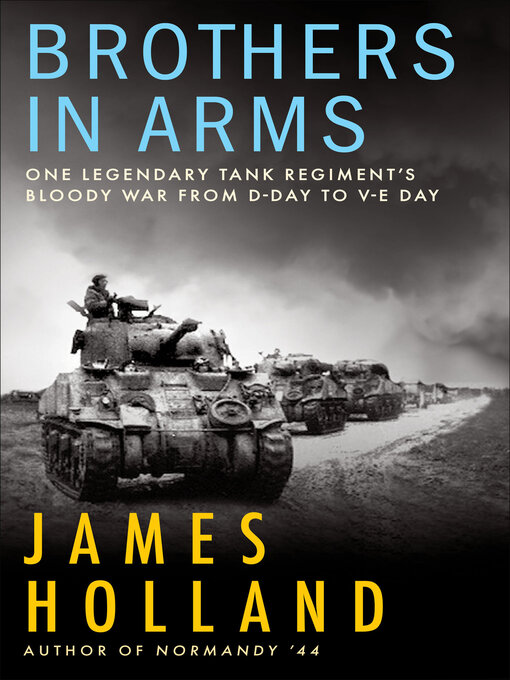Brothers in Arms
One Legendary Tank Regiment's Bloody War from D-Day to V-E Day
One of the last cavalry units to ride horses into battle, the Sherwood Rangers were transformed into a “mechanized cavalry” of tanks in 1942. After winning acclaim in the North African campaign, they spearheaded one of the D-Day landings in Normandy and became the first British troops to cross into Germany. Their courage, skill and tenacity contributed mightily to the surrender of Germany in 1945.
Inspired by Stephen Ambrose’s Band of Brothers, historian James Holland profiles this extraordinary group of citizen soldiers. Informed by never-before-seen documents, letters, photographs, and other artifacts from Sherwood Rangers’ families, Holland offers a uniquely intimate portrait of the war at ground level.
Brothers in Arms introduces heroes such as Commanding Officer Stanley Christopherson, squadron commander John Semken, Sergeant George Dring, and others who helped their regiment earn the most battle honors of any in British army history. Weaving their exploits into the larger narrative of D-Day to V-E Day, Holland offers fresh analysis and perspective on the endgame of WWII in Europe.
-
Creators
-
Publisher
-
Release date
November 16, 2021 -
Formats
-
Kindle Book
-
OverDrive Read
- ISBN: 9780802159090
-
EPUB ebook
- ISBN: 9780802159090
- File size: 172501 KB
-
-
Languages
- English
-
Reviews
-
Publisher's Weekly
September 20, 2021
The heroic exploits of the British Army’s Sherwood Rangers tank unit over the last 11 months of WWII are richly documented in this sweeping chronicle from historian Holland (Sicily ’43). After helping to secure victory in North Africa, the regiment, which up until 1941 had fought on horses, re-assembled and trained in England before taking part in the D-Day landings at Normandy. Weeks of “inch-by-inch, yard-by-yard” fighting ensued, as regimental officers struggled to coordinate with infantry, artillery, and air support, while crews quickly learned how to get out of a burning tank before being incinerated. Holland describes the unit’s chaplain bringing bodies back from the front lines for burial, and commanding officer Stanley Christopherson’s agony over the condolence letters he wrote to families. There are also lighter moments, such as when a trio of officers swilled champagne at the Hotel Ritz in recently liberated Paris. By the time the Rangers crossed the German border in November 1944, the regiment had suffered more than 300 casualties. In May 1945, they were battling the last diehard Nazis near Bremen when word came down that Germany had finally surrendered. Vivid eyewitness accounts, colorful character sketches, and lucid tactical discussions make this a must-read for military history buffs. Agent: Patrick Walsh, PEW Literary. -
Kirkus
September 15, 2021
A fine account of the brutal daily experiences of a celebrated British tank regiment. World War II historiography received a shot in the arm with Stephen Ambrose's 1992 book, Band of Brothers, which eschewed the traditional campaigns-and-commanders format to describe a single unit's experience. In his latest, veteran military historian Holland, author of more than 10 books about WWII, tries his hand successfully with the Sherwood Rangers. A British cavalry regiment throughout World War I, in 1942, the Rangers converted to armor in time to fight at El Alamein and then across North Africa. Withdrawn to Britain, they trained throughout early 1944 and then came ashore on Gold Beach on D-Day. This book is the result of massive research in British and American archives, plus a few interviews with survivors, and the author includes a generous selection of maps and photos. The text is best suited for military buffs, as Holland delivers an intense, 400-page description of the regiment's nearly yearlong battle across France, Belgium, and Germany. An expert military historian, the author steps back regularly from battlefield fireworks to explain tactics and technical details. The Rangers mostly drove American Sherman tanks, denigrated from the beginning for having smaller guns and less armor than German tanks, but Holland records few complaints. They were reliable, easy to operate, and quick to repair compared to German behemoths, and they could fire a shell every three seconds. The regiment's Shermans destroyed many Tigers and Panthers, and shells that bounced off distracted their operators. Readers who assume that it was safer to be inside a tank will quickly realize their error thanks to Holland's precise accounts. Casualties were high, and deaths often gruesome from burns or suffocation. Many popular historians write that German resistance collapsed once the Allies crossed the Rhine, but this wasn't the experience of the Rangers, who fought and died until a few days before the end. One of the better recent blow-by-blow chronicles of a World War II unit.COPYRIGHT(2021) Kirkus Reviews, ALL RIGHTS RESERVED.
-
Formats
- Kindle Book
- OverDrive Read
- EPUB ebook
subjects
Languages
- English
Loading
Why is availability limited?
×Availability can change throughout the month based on the library's budget. You can still place a hold on the title, and your hold will be automatically filled as soon as the title is available again.
The Kindle Book format for this title is not supported on:
×Read-along ebook
×The OverDrive Read format of this ebook has professional narration that plays while you read in your browser. Learn more here.


